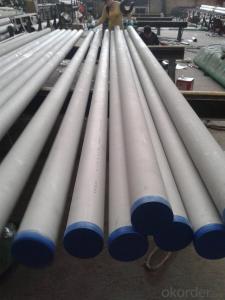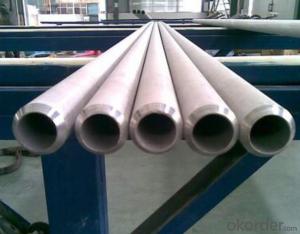Stainless steel tube; round/square
- Loading Port:
- Shanghai
- Payment Terms:
- TT OR LC
- Min Order Qty:
- 25 m.t.
- Supply Capability:
- 2000 m.t./month
OKorder Service Pledge
OKorder Financial Service
You Might Also Like
Specifications
tp321 stainless steel tube
1.WT:0.08-12.8mm
2.OD:0.25-50.8mm
3.Sample cost free for VIP customers
4.MOQ:25kgs
321 stainless steel tube
1. WT: 0.08-12.8mm
2. OD: 0.25-50.8mm
3. MOQ: 25 kgs
4. Sample cost free for VIP customer
Steel grade : 301(1Cr17Ni17),304 Moderate Frequency (0Cr18Ni9),304 AOD (0Cr18Ni9),304L(00Cr19Ni10) ,321 M oderate Frequ ency (1Cr18Ni9Ti),321 AOD (1Cr18Ni9Ti),316(0Cr17Ni12Mo2),316L(00Cr17Ni14Mo2),310S(0Cr25Ni20) ,317L(00Cr19Ni13Mo3)
Specification : GB/T14975-2002,GB/T14976-2002,GB13296-91,GB9948-88 ASTM/ASME A213/SA213,ASTM/ASME A312/SA312,ASTM/ASME A269/SA269,DIN 17458-85,DIN 17456-85,JIS G 3459,JIS G 3463,JIS G 3448 JIS G 3446.
Product Information of stainless steel:
- Width: customized
- Surface: 2B/BA/6K/8K/NO.4/HL.
- Thickness: 0.3mm - 3.0mm.
- Delivery time: 15-25 days.
- Length : As customer's requirement.
- Package: With export standard packing or customize packing.
- Payment Terms: T/T (30% deposit pay in advance and the balance before shipment) , irrevocable L/C.
Company advantage:
-Top Equipments, Leading In The Industry.
- Professional Team, Leading Innovation.
- Huge Supply Capacity Advantage, Timely and Effective Delivery.
- Modern Logistic, Fact and Convenient.
- Precise Manufacturing, Exquisite Products.
- Serve People, Create Value.
- Dimensional Network, Powerful Expansion.

- Q:Are stainless steel pipes suitable for irrigation systems?
- Indeed, irrigation systems find stainless steel pipes to be a fitting choice. Renowned for their exceptional resistance to corrosion, durability, and strength, stainless steel pipes prove to be an ideal selection for irrigation systems that face constant exposure to water and moisture. These pipes possess the capability to endure high-pressure circumstances and guard against rust and corrosion, guaranteeing a lengthy lifespan and necessitating minimal maintenance. Furthermore, stainless steel pipes ensure the safety of conveying water for irrigation purposes, as they refrain from leaching any harmful substances into the water supply.
- Q:Are stainless steel pipes suitable for high-temperature environments?
- Indeed, high-temperature environments are well-suited for stainless steel pipes. Renowned for their remarkable resistance to heat, stainless steel pipes are highly favored for applications in such conditions. They have the ability to endure a broad range of temperatures, from freezing to exceedingly high levels, all while maintaining their mechanical integrity. Consequently, stainless steel pipes prove to be the perfect choice for industries like oil and gas, chemical processing, and power generation, where elevated temperatures prevail. Furthermore, the exceptional corrosion resistance possessed by stainless steel pipes further augments their appropriateness for high-temperature settings.
- Q:What are the maintenance requirements for stainless steel pipes?
- Compared to other materials, stainless steel pipes have relatively low maintenance requirements. However, to ensure their longevity and optimal performance, there are a few key steps that should be taken. To begin with, it is essential to regularly clean the pipes to remove any dirt, grime, or contaminants that may accumulate on the surface. This can be accomplished by using mild soap and water or a non-abrasive cleaner. It is crucial to avoid the use of abrasive materials or harsh chemicals as they can cause damage to the stainless steel surface. Periodically inspecting the pipes is also recommended to check for any signs of corrosion or damage. While stainless steel is known for its corrosion resistance, there are certain environments or conditions that can still make it susceptible. Addressing any signs of corrosion promptly is important to prevent further deterioration. Protecting the stainless steel pipes from physical damage or impact is another important factor. This can be achieved by avoiding heavy objects from hitting or rubbing against the pipes and using suitable padding or insulation in areas where they may be exposed to potential impact. Lastly, it is crucial to ensure that the stainless steel pipes are installed and used in accordance with their intended purpose and within their specified temperature and pressure limits. This will help prevent any unnecessary stress or strain on the pipes, which could result in premature failure. By adhering to these maintenance requirements, stainless steel pipes can offer long-lasting durability and performance in various applications.
- Q:Are stainless steel pipes suitable for liquid storage tanks?
- Yes, stainless steel pipes are suitable for liquid storage tanks. Stainless steel has excellent corrosion resistance properties, making it ideal for storing various liquids, including water, chemicals, and food products. The material is highly resistant to rust, oxidation, and staining, ensuring that the stored liquids remain uncontaminated. Stainless steel pipes also have high strength and durability, allowing them to withstand the pressure and weight of the stored liquids. Additionally, stainless steel is easy to clean and maintain, making it a reliable choice for liquid storage applications.
- Q:What is stainless steel decorative tube? What uses does it have?
- For the steel to withstand the pressure to the hydraulic test to test its ability and quality, leakage, soaked or expansion for qualified does not occur at the prescribed pressure, some steel according to the requirement of standard or edge test, flaring test and flattening test.Seamless stainless steel tube, also called stainless steel seamless pipe, is made of ingot or solid tube blank by piercing, and then made by hot rolling, cold rolling or cold casting. Specifications for seamless steel tubes are expressed in millimeters of outer diameter * wall thickness.
- Q:What is the difference between SCH and XS stainless steel pipes?
- SCH and XS are both schedules used to classify stainless steel pipes based on their wall thickness. However, the main difference lies in the wall thickness itself. SCH stands for Schedule and is a numerical representation indicating the pipe's wall thickness, while XS stands for Extra Strong and represents pipes with a thicker wall compared to SCH pipes.
- Q:How do you prevent erosion in stainless steel pipes?
- To prevent erosion in stainless steel pipes, several measures can be taken. 1. Proper material selection: Choosing a high-quality grade of stainless steel with good resistance to erosion, such as 316 or duplex stainless steel, can significantly reduce the risk of erosion. 2. Corrosion-resistant coatings: Coating the internal surface of the stainless steel pipes with a corrosion-resistant material can provide an extra layer of protection against erosion. Epoxy coatings, for example, are commonly used to protect against erosion in pipes. 3. Flow control: Managing the flow rate and velocity of the fluid passing through the pipes is crucial in preventing erosion. High flow rates and excessive turbulence can accelerate the erosion process. Implementing flow control devices like flow restrictors or flow baffles can help regulate the fluid velocity, minimizing erosion. 4. Regular maintenance and inspection: Conducting routine inspections to identify any signs of erosion or corrosion is essential. This allows for timely repairs or replacements of affected sections before erosion becomes severe. Additionally, regular cleaning and flushing of the pipes can help remove any sediment or debris that may contribute to erosion. 5. Proper pipe installation: Ensuring that the pipes are properly installed and supported can help prevent damage caused by vibrations or excessive movement. Proper alignment and support can reduce stress on the pipes, minimizing the risk of erosion. 6. Fluid properties: Understanding the properties of the fluid being transported through the stainless steel pipes is important in preventing erosion. For instance, if the fluid contains abrasive particles, implementing filtration systems or using strainers can help remove these particles before they reach the pipes, reducing erosion. 7. Education and training: Providing education and training to personnel involved in the operation and maintenance of the pipes is crucial. This includes training on proper handling, maintenance, and troubleshooting techniques to identify and address erosion-related issues promptly. By implementing these preventive measures, erosion in stainless steel pipes can be effectively minimized, ensuring their longevity and optimal performance.
- Q:Can stainless steel pipes be used for nuclear applications?
- Yes, stainless steel pipes can be used for nuclear applications. Stainless steel is commonly used in nuclear power plants due to its excellent corrosion resistance, high strength, and ability to withstand high temperatures. It is particularly suitable for applications where the pipes come into contact with various nuclear substances or corrosive environments. Stainless steel pipes are used for transporting and containing nuclear materials, such as coolant, steam, and radioactive waste. They are also used in the construction of nuclear reactors, where the pipes need to withstand extreme conditions, including high pressure and radiation exposure. Additionally, stainless steel pipes offer long-term durability and reliability, making them a preferred choice for nuclear applications.
- Q:Are stainless steel pipes suitable for underground heating systems?
- Yes, stainless steel pipes are suitable for underground heating systems. Stainless steel is highly resistant to corrosion, making it ideal for underground applications where pipes are exposed to moisture and other harsh conditions. Additionally, stainless steel pipes have excellent thermal conductivity, ensuring efficient heat transfer throughout the system.
- Q:How do stainless steel pipes compare to concrete pipes?
- Stainless steel pipes and concrete pipes each have their own advantages and disadvantages, and their suitability for specific applications may vary. Stainless steel pipes are known for their durability, corrosion resistance, and high strength-to-weight ratio. They can withstand extreme temperatures, making them ideal for applications that involve high-pressure fluids or gases, such as in the oil and gas industry. Stainless steel pipes are also commonly used in food processing, chemical plants, and wastewater treatment facilities due to their hygienic properties and resistance to chemicals. Additionally, stainless steel pipes have a smooth interior surface, which reduces friction and allows for efficient fluid flow. On the other hand, concrete pipes are known for their strength, longevity, and resistance to external loads. They are commonly used in sewer systems, stormwater drainage, and culverts due to their ability to withstand heavy traffic loads and high groundwater pressures. Concrete pipes are also fire-resistant and provide excellent insulation, making them suitable for applications where fire protection is crucial. In terms of cost, stainless steel pipes are generally more expensive than concrete pipes. However, stainless steel pipes require minimal maintenance and have a longer lifespan, which can offset the initial cost. Concrete pipes, although cheaper, may require more frequent repairs and have a shorter lifespan. Ultimately, the choice between stainless steel pipes and concrete pipes depends on the specific requirements of the project, including factors such as the intended application, environmental conditions, budget, and lifespan expectations. Consulting with a professional engineer or specialist in pipe materials can help ensure the selection of the most appropriate pipe material for a particular project.
1. Manufacturer Overview |
|
|---|---|
| Location | |
| Year Established | |
| Annual Output Value | |
| Main Markets | |
| Company Certifications | |
2. Manufacturer Certificates |
|
|---|---|
| a) Certification Name | |
| Range | |
| Reference | |
| Validity Period | |
3. Manufacturer Capability |
|
|---|---|
| a)Trade Capacity | |
| Nearest Port | |
| Export Percentage | |
| No.of Employees in Trade Department | |
| Language Spoken: | |
| b)Factory Information | |
| Factory Size: | |
| No. of Production Lines | |
| Contract Manufacturing | |
| Product Price Range | |
Send your message to us
Stainless steel tube; round/square
- Loading Port:
- Shanghai
- Payment Terms:
- TT OR LC
- Min Order Qty:
- 25 m.t.
- Supply Capability:
- 2000 m.t./month
OKorder Service Pledge
OKorder Financial Service
Similar products
New products
Hot products
Hot Searches
Related keywords





























